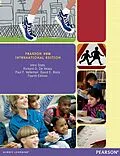Richard De Veaux, Paul Velleman, and David Bock wrote Intro Stats with the goal that students and instructors have as much fun reading it as they did writing it. Maintaining a conversational, humorous, and informal writing style, this edition engages students from the first page.
The authors focus on statistical thinking throughout the text and rely on technology for calculations. As a result, students can focus on developing their conceptual understanding. Innovative Think/Show/Tell examples give students a problem-solving framework and, more importantly, a way to think through any statistics problem and present their results.
New to the 4th Edition is a streamlined presentation that keeps students focused on what's most important, while including out helpful features. An updated organisation divides chapters into sections, with specific learning objectives to keep students on track. A detailed table of contents assists with navigation through this new layout. Single-concept exercises complement the existing mid- to hard-level exercises for basic skill development.
The full text downloaded to your computer
With eBooks you can:
- search for key concepts, words and phrases
- make highlights and notes as you study
- share your notes with friends
eBooks are downloaded to your computer and accessible either offline through the Bookshelf (available as a free download), available online and also via the iPad and Android apps.
Upon purchase, you'll gain instant access to this eBook.
Time limit
The eBooks products do not have an expiry date. You will continue to access your digital ebook products whilst you have your Bookshelf installed.
Autorentext
Dick De Veaux (Williams College) is an award-winning teacher and consultant to major corporations. His real-world experiences and anecdotes illustrate many of the chapters. Dick has taught business students at Wharton, engineering students at Princeton, and liberal arts students at Williams. Dick was named the 2008 Mosteller Statistician of the Year, awarded by the Boston chapter of the American Statistical Association for exceptional contributions to the field of statistics and outstanding service to the statistical community. To learn more, please go to: http://www.williams.edu/admin/news/releases/1624/.
Paul Velleman (Cornell University) is the only statistician to win the EDUCAUSE award for innovating technology for learning. The developer of ActivStats® multimedia software, Data Desk® statistics software, and the DASL online archive of teaching datasets, his understanding of using and teaching with technology informs much of the book's approach.
David Bock (Cornell University) won awards as a high school teacher of AP calculus and statistics and was a grader for the AP Statistics program from its inception. He is now the chief extension officer for the Cornell University mathematics department in charge of outreach to K-12 teachers. Dave's wisdom about how students learn helps to shape the book's pedagogy.
Inhalt
- Preface
- Index of Applications
- Part I. Exploring and Understanding Data
- 1. Stats Starts Here!
- 2. Displaying and Describing Categorical Data
- 3. Displaying and Summarizing Quantitative Data
- 4. Understanding and Comparing Distributions
- 5. The Standard Deviation as a Ruler and the Normal Model
- Part II. Exploring Relationships Between Variables
- 6. Scatterplots, Association, and Correlation
- 7. Linear Regression
- 8. Regression Wisdom
- Part III. Gathering Data
- 9. Understanding Randomness
- 10. Sample Surveys
- 11. Experiments and Observational Studies
- Review of Part III: Gathering Data
- Part IV. Randomness and Probability
- 12. From Randomness to Probability
- 13. Probability Rules!
- 14. Random Variables and Probability Models
- Part V. From the Data at Hand to the World at Large
- 15. Sampling Distribution Models
- 16. Confidence Intervals for Proportions
- 17. Testing Hypotheses About Proportions
- 18. Inferences About Means
- 19. More About Tests and Intervals
- Part VI. Learning About the World
- 20. Comparing Groups
- 21. Paired Samples and Blocks
- 22. Comparing Counts
- 23. Inferences for Regression
- Review of Part VI: Learning About the World
- Part VII. Inference When Variables Are Related
- 24. Analysis of Variance
- Appendices
- A. Answers
- B. Photo Acknowledgments
- C. Index
- D. Tables and Selected Formulas
